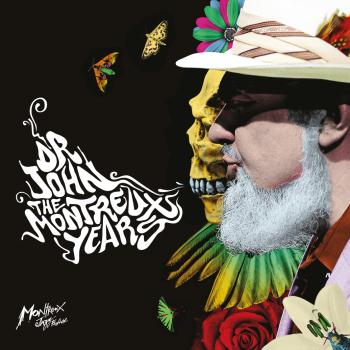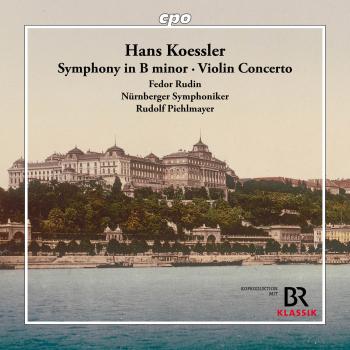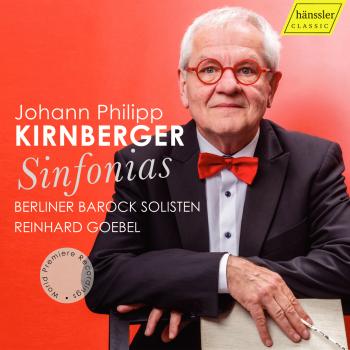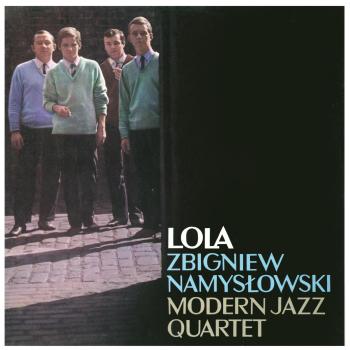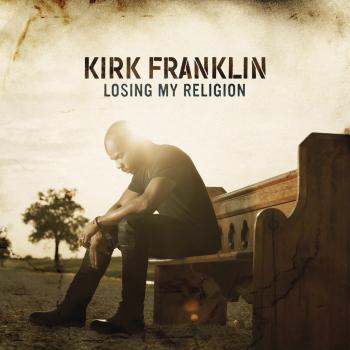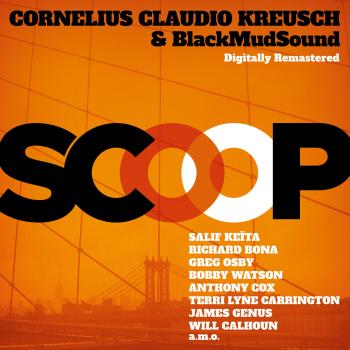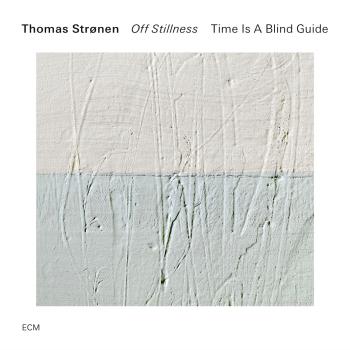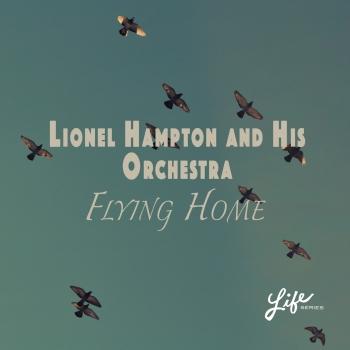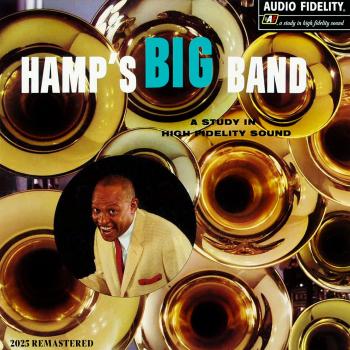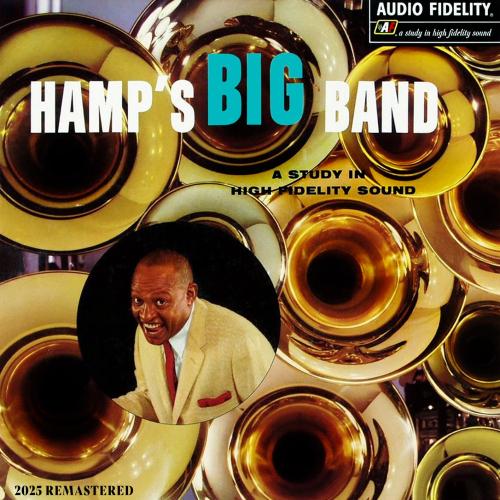
Hamp's Big Band (2025 Remastered) Lionel Hampton and His Orchestra
Album Info
Album Veröffentlichung:
1959
HRA-Veröffentlichung:
01.08.2025
Das Album enthält Albumcover
- 1 Flying Home (2025 Remastered) 04:49
- 2 Hey, Baba Re Bob (2025 Remastered) 05:56
- 3 Hamp's Boogie Woogie (2025 Remastered) 04:12
- 4 Kidney Stew (2025 Remastered) 02:26
- 5 Hamp's Mambo (2025 Remastered) 03:15
- 6 Airmail Special (2025 Remastered) 03:02
- 7 Big Brass (2025 Remastered) 03:20
- 8 Red Top (2025 Remastered) 03:36
- 9 Night Train (2025 Remastered) 03:01
- 10 Elaine & Daffy (2025 Remastered) 03:35
- 11 Cutter's Corner (2025 Remastered) 03:08
- 12 Le Chat Noir (2025 Remastered) 03:32
Info zu Hamp's Big Band (2025 Remastered)
Die ersten zwölf Tracks dieser Auswahl zeigen Lionel und seine Big Band. With solid harmonies, full tonal texture and squared off rhythms. Lionel Hampton hebt seinen berühmten Stil auf neue Höhen mit größerer Betonung auf harmonisches Design. Dies zeigt sich in Auswahlen wie "Big Brass", "Night Train" und "Airmail Special". In Momenten ist der Gesamteffekt fast hypnotisch und das gilt vor allem bei "Cutter's Corner", "Le Chat Noir" und "Hamp's Boogie Woogie". Nicht jeder Jazz-Musiker kann sich leidenschaftlich und gleichermaßen gut auf mehr als einem Instrument ausdrücken, das Geheimnis ist Improvisation, und hier ist Lionel Hampton wirklich begabt und er zeichnet sich durch Auftritte von "Blues For Stephen", "And The Angels Sing", "Lazy Thoughts" und dem seminalen "Wiegenlied von Birdland" aus. Es gibt Momente, in denen die Rhythmen so kraftvoll dynamisch in Kraft sind und das daraus resultierende Klangmosaik wirklich überwältigend in seiner Intensität ist. Dies ist ein Muss für Jazz-Fans!
Eddie Williams, Trompete
Ed Mullens, Trompete
Art Hoyle, Trompete
Dave Gonsalves, Trompete
Donald Byrd, Trompete
Cat Anderson, Trompete
Clarence Watson, Posaune
Lou Blackburn, Posaune
Wade Marcus, Posaune
Bobby Plater, Altsaxophon
Ed Pazant, Altsaxophon
Herman Green, Tenorsaxophon
Andrew McGhee, Tenorsaxophon
Lonnie Shaw, Baritonsaxophon
Lionel Hampton, Vibraphon, Percussion, Schlagzeug, Cello
Wade Legge, Klavier
Billy Mackel, Gitarre
Lawrence „Skinny“ Burgan, Kontrabass
Charlie Persip, Wilbert „G.T.“ Hogan, Schlagzeug
Cornelius „Pinochio“ James, Cello (auf „Kidney Stew“)
Digitally remastered
Lionel Hampton and His Orchestra
One of the most high-profile bands of its day, Lionel Hampton’s orchestra broke new musical ground and helped pioneer rhythm and blues (R&B). Hampton founded his big band in 1940 after leaving Benny Goodman’s band. Though Hampton’s existing stardom gave the band immediate good favor in the jazz world, the band’s prominence reached new heights with their 1942 recording of “Flying Home.” The recording featured an electrifying tenor solo from Illinois Jacquet, and many consider the record one of the first R&B recordings. “Flying Home” became an anthem for Hampton and Jacquet, the both would continue performing it throughout their careers. R&B also became a more central part of the Hampton band’s sound, and later iterations of the group included figures like Charles Mingus, Wes Montgomery, and Johnny Griffin.
Lionel Hampton
Featuring outstanding sidemen and soloists, as well as his own swinging vibe playing, Lionel Hampton's bands during the 1940s and 1950s were among the most popular and most exciting in jazz. Hampton was raised in the Midwest, primarily in Kenosha, Wisconsin, where he received his first musical training. His career began behind the drums, taking his first music job in a newsboys' band sponsored by the Chicago Defender.
In 1928, Hampton moved west to California, landing first in the Paul Howard Orchestra, later working with bandleaders Eddie Barefield and Les Hite. In 1929 he took up the vibraphone with the Hite band, which at the time was led by Louis Armstrong, becoming a pioneering figure in the use of vibes in a jazz band.
Hampton made his recorded debut on an Armstrong version of "Memories of You" in 1930. By 1934, Hampton had become leader of his own band, performing at Sebastian's Cotton Club in Los Angeles. Benny Goodman saw Hampton perform at one of his gigs and recruited him to augment his trio, with Teddy Wilson and Gene Krupa, for a 1936 recording date. Hampton remained in Goodman's band through 1940, occasionally replacing Krupa on the drums. Hampton became well known with the Goodman band, and started his own big band, achieving his biggest recorded hit with "Flying Home" in May 1942, driven by Illinois Jacquet's unforgettable tenor saxophone solo.
Hampton's popular big band boasted such potent musicians as Dexter Gordon, Clifford Brown, Fats Navarro, Johnny Griffin, Charles Mingus, Art Farmer, Clark Terry, Cat Anderson, Wes Montgomery, and singers Dinah Washington, Joe Williams, Betty Carter, and Aretha Franklin. He toured the globe and continued to nurture young talent, often providing some of the earliest band experiences to musicians who went on to become leaders in their own right. His band became the longest established orchestra in jazz history.
Lionel Hampton received numerous awards of merit, including several honorary doctoral degrees, the National Medal of Arts, and the Kennedy Center Honors. His diligent work with the jazz festival at the University of Idaho in Moscow led to it being renamed the Lionel Hampton International Jazz Festival in 1985. The university's music department shortly followed suit and became the Lionel Hampton School of Music. Winner of numerous polls, Hampton had been an honored soloist into the 1990s, performing in numerous festivals as part of all-star assemblages. In 2001, he donated his vibraphone to the Smithsonian Institution.
Dieses Album enthält kein Booklet

